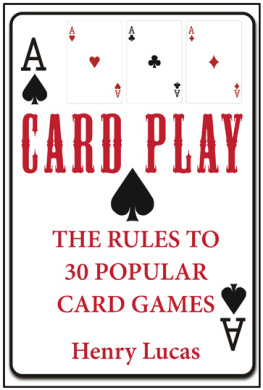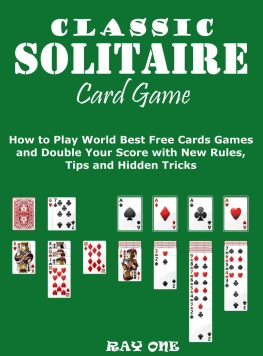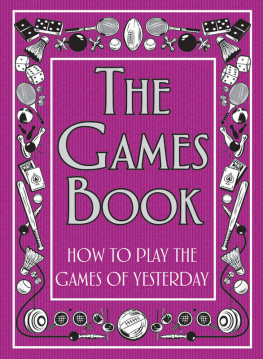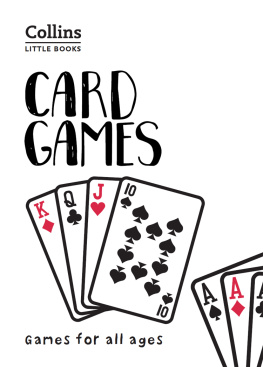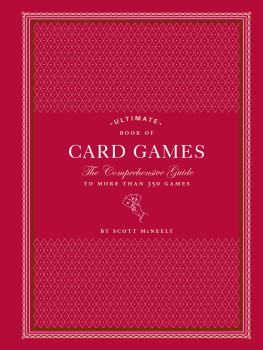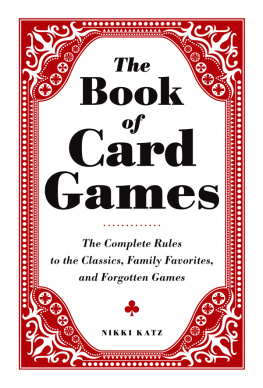Cover
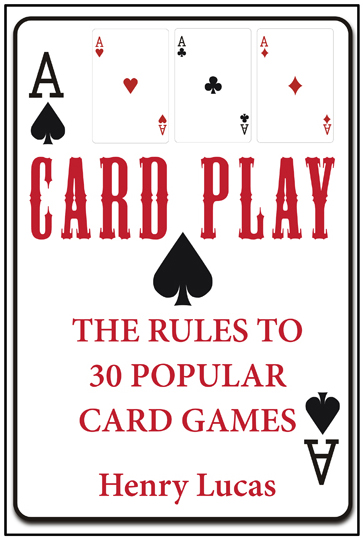
Title Page
Card Play
The Rules to 30 Popular Card Games
Henry Lucas

Copyright
Beyond the Page Books
are published by
Beyond the Page Publishing
www.beyondthepagepub.com
Copyright 2011 by Beyond the Page Publishing
Cover design and illustration by Lance Lionetti
ISBN: 978-1-937349-07-3
All rights reserved under International and Pan-American Copyright Conventions. By payment of required fees, you have been granted the non-exclusive, non-transferable right to access and read the text of this book. No part of this text may be reproduced, transmitted, downloaded, decompiled, reverse engineered, or stored in or introduced into any information storage and retrieval system, in any form or by any means, whether electronic or mechanical, now known or hereinafter invented without the express written permission of the publisher.
Limit of Liability/Disclaimer of Warranty: While the publisher and author have used their best efforts in preparing this book, they make no representations or warranties with respect to the accuracy or completeness of the contents of this book and specifically disclaim any implied warranties of merchantability or fitness for a particular purpose. No warranty may be created or extended by sales representatives or written sales materials. The advice and strategies contained herein may not be suitable for your situation. You should consult with a professional where appropriate. Neither the publisher nor the author shall be liable for any loss of profit or any other commercial damages, including but not limited to special, incidental, consequential, or other damages.
Contents
Classic Games
1. Cribbage (6-Card Version)
WHAT YOU NEED
1 complete deck of cards
2 players
1 Cribbage board
1 pen
1 pad or sheet of paper
OBJECT OF THE GAME
The object of Cribbage is to be the first player to achieve a score of 61 (or 121) over a series of matches. Points are accumulated by forming card combinations during the game.
KEY TERMS
The crib (also known as the box) A stack of 4 cards (2 from each players hand) formed before each deal. Points from these cards benefit only the dealer at the end of each deal.
The start card A card turned faceup on top of the stack before play, this card can be counted toward combinations in both players hands at the end of each play.
CARD VALUES
Ace (A) = 1 point (aces are low)
210 = face value
Jack (J), Queen (Q), and King (K) = 10 points each
CARD COMBINATIONS
15 = 2 points
31 = 2 points
Pair (two cards of the same rank) = 2 points
Pair royal (three successive face cards of the same rank) = 6 points scored by the person who lays the third card down.
Double pair royal (four cards of the same rank) = 12 points, scored by the person who lays the fourth card down.
Run (three or more cards of consecutive rank; they dont have to follow suit or go in order) = value is equal to number of cards placed. Examples:
Run Example 1
Lets say the run order is 4-2-3-5-6. The person who places the 3 scores 3 points. The player who places the 5 scores 4 points (because 5 is the fourth card placed in the run). The player who places the 6 scores 5 points.
Run Example 2
Lets say the run order is 4-2-3-4-3. The player who puts down the first 3 scores 3 points for the run 4-2-3. The player who placed the second 4 scores 3 points for the run 2-3-4. The last 3 is not worth any points because it does not complete any kind of consecutive run.
GAME PLAY
Each player accumulates points by forming certain card combinations during the game.
Players keep score by recording points on a board that has holes where the pegs will be placed. The cribbage board is placed between the two players. Each hole on the board is equivalent to one point. Each player has two pegs; one peg represents the current running score and the other peg marks points from the last hand. In other words, each time a new game is started, each player must alternate which pegs to use to move ahead. The rear peg is always moved at the start of each new hand by starting scoring at the first hole in front of the front peg.
Cut the cards to see who deals first. The person who cuts the lowest card will be the dealer. As compensation for not being the winner of the cut, the opposing player gets to peg ahead three points. You only cut cards in this manner on the first deal. After the first deal, you alternate the deal. The dealer then shuffles the cards and the opposing player cuts them. Six cards are then dealtone at a timeto each player. The undealt cards are placed facedown on the table.
At this point, each player must place two cards from his or her hand to form the crib, which is set aside until the end of the game. The non-dealer should plan to give nonvaluable cards (those that wont form any combinations) to the crib, because the crib only benefits the dealer at the end of the game.
When the cards are dealt and the crib has been formed, it is time to choose a start card. This is done by both players. The non-dealer cuts the cards and the dealer takes the top card from the bottom part of the cut and turns it faceup on top of the stack. This card is called a start card.
If the start card is a Jack, then the dealer gets to peg ahead two points. The expression for this play is two for his heels. The dealer then does likewise. Each player alternates playing his cards, calling out the total point value of the cards with each card placed. Plays are made to one pile. In other words, each player adds cards to the same pile and adds the card to the total value as the game goes on.
One player turns a card and says the total value, then the next player turns a card and says the new total value, and so on. For example: If the pile is at 10 points and the next player places a 3, then he says 13. This part of the game is not unlike Blackjack, only the object is to score to 31 and not 21and each player plays to one pile instead of individual piles.
The players keep laying cards down until the total 31 is reached. At this point of the game, 31 points cannot be exceeded. If a player places the card that brings the total to exactly 31, he gets to move his peg forward 2 points and the play is complete.
If the game cannot be continued without going over 31 points, dont play a card, but instead say, Go. If the opposing player says Go also, it means both players have either used all the cards in their respective hands or the players have cards that are too high to score 31 or less. If neither player can score 31, the play ends and the last player to play a card pegs ahead 1 for the last card. Continue playing until all the cards have been playedstart at zero again each time 31 has been reached or both players say Go.
The non-dealer starts by turning a card faceup on the table. The dealer then does likewise. Each player alternates playing his cards, calling out the total point value of the cards with each card placed. Plays are made to one pile. In other words, each player adds cards to the same pile and adds the card to the total value as the game goes on.
THE SHOW
At the end of the game, the players count up the cards from their handsfirst the dealer, then the non-dealer. The cards are scored. The start card also counts toward combinations.
Possible Combinations
15 = Any combination adding up to 15 points scores 2 points. So, if a players hand at the end of the game contains a King, a Queen, and two 5s, that player would score 8 points. (Look at the start card to see if he could possibly get more.) Heres why: the player has four 15s because each face card can be paired with each 5. So the player would say aloud fifteen-two, fifteen-four, fifteen-six, fifteen-eight, indicating how many 15s a player has in his hand plus his point valueending with the final tally of 8.
Next page
